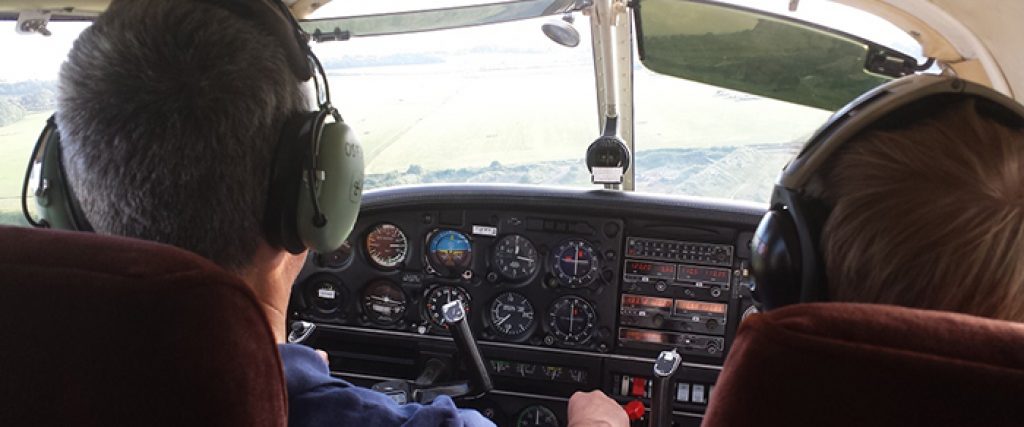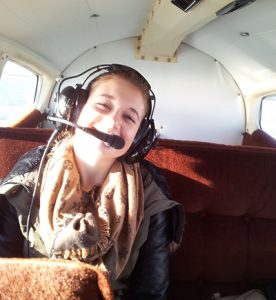
Your first ever flying lesson will be conducted by a fully qualified flying instructor, who can start you on your path towards being awarded that coveted Private Pilot’s License. However, occasionally a flying instructor will be asked to fly a lesson in order to help vanquish someone’s fear of flying. This is more common than you might think; and happily, we can report that often a little knowledge, reassurance and flying experience can go a long way towards dispelling fears.
Whilst none of the advice we espouse in this article should override that of trained medical and psychological professionals, here we show how a light aircraft trial lesson can help alleviate fear of flying.
Knowledge Dispels Fear
It’s worth noting straight away that fear of flying is not, in fact, irrational. Flight is not a natural state of being for humans (although we’ll be the first to admit it’s pretty damn cool). Human beings have evolved over more than one hundred thousand years to adapt to a sensorium limited to a few miles visibility at ground level, and top speeds of maybe twenty miles per hour.
It’s only over the last one hundred years or so that our species has been able to get airborne; thus, our natural inbuilt senses and instincts can sometimes (quite naturally) override our logically educated brains.
But – crucially – we also do feel a whole lot better about scary things when we understand them. Given that the average human is not familiar with the nuances and safe practices of aviation, unfounded fears can understandably arise, based on incomplete data.
Knowing why an aircraft is doing a particular something, making a particular noise, or even just the theory and effects of aerial turbulence (for example) can go a huge way towards quelling fear. And knowing how various hazards are mitigated – or that they don’t exist at all – could even eliminate fears altogether.
How Your Instructor Can Help
With that in mind, (and with the proviso that your friendly flight instructor’s tuition will take precedence) a trial lesson can do a number of things to help.
Ask your instructor to show you how the aircraft’s flight controls work – and to have a go yourself (all training aircraft will have dual controls; your instructor will never be more than a verbal handover away). This also forms the first lesson in your private pilot’s license. It’s also helpful to know some reassuring facts (most of these can also be broadly applied to flying on a commercial airliner);

Stability
All save somewhat exotic aircraft are designed with positive stability. Ask your instructor to demonstrate this – if properly trimmed out, a light aircraft should be able to be flown “hands off”, and not deviate from level flight – it’s designed to be safe and easy. Every commercial and training aircraft has been designed to be stable.
Engine failure
Most light training aircraft have one engine; therefore an integral part of flight training deals with engine failure drills. A typical light aircraft can glide for miles – and still land safely in an area the size of a football field – without an engine. If you feel up to it, ask the instructor to demonstrate a Practice Forced Landing (PFL). This flight exercise simulates an engine failure and subsequent glide to land. Note; unless flown onto an airfield, most PFLs will revert back to normal flight at a safe altitude BEFORE they touch down.

Turbulence
All aircraft will experience turbulence to some degree; and all aircraft are designed to safely ride out all but the very worst. Pilots will avoid the worst assiduously! If you are particularly keen to avoid any turbulence at all, book a lesson as early or as late in the day as possible, and one free of thunderstorms or cumulus clouds wherever possible. This will minimise the amount of turbulence felt (an early morning sunrise flight can often feel like ‘flying on rails’!)
And finally – remember, statistically, you’re in fact much more likely to have an accident driving to and from the airport than when flying from it! Experiencing a trial flying lesson, combined with an understanding of why pilots and aircraft will do the things they do, can go a long way toward conquering a fear of flying. And of course – we hope you too can enjoy the wonderful gift of flight.
Happy fearless flying!







